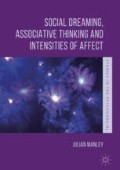Abstract
Before discussing the Deleuzian approach to social dreaming formulated in the previous chapter, this chapter discusses the origins of the social dreaming project in ideas that have their roots in the work of Bion, Bollas and Winnicott. The inventor or ‘discoverer’ of social dreaming, Gordon Lawrence, developed social dreaming while immersed in the world of the Tavistock and group relations and social dreaming emerged both from and as a reaction against that world.
Access this chapter
Tax calculation will be finalised at checkout
Purchases are for personal use only
References
Bion, W.R. (1967). Second thoughts. London: Maresfield.
Bion, W.R. (1970). Attention and interpretation. London: Karnac.
Bion, W.R. (2000). Experiences in Groups and other papers. London: Routledge.
Bollas, C. (1987). The Shadow of the Object. London: Free Association.
Clare, J. and Zarbafi, A. (2009). Social Dreaming in the 21st Century. London: Karnac.
Ferrero, A. (2002). Some implications of Bion’s thought. The waking dream and narrative derivatives. The International Journal of Psychoanalysis, 83(3), pp. 597–607.
Lawrence, W. G. (2005). Introduction to Social Dreaming. Transforming Thinking. London: Karnac.
Long, S. (2013). Socioanalytic Methods. London: Karnac.
Long, S. (in press). Dreams and Dreaming: A Socioanalytic and Semiotic Perspective. In Long, S. and Manley, J. (Eds.), Social Dreaming: Philosophy research and practice. London: Routledge.
Manley, J. (2018). ‘Every human being is an artist’: From social representation to creative experiences of self. In Cummins, A.M. and Williams, N. (Eds.), Researching Beneath the Surface, Vol. 2. London: Routledge.
Manley, J. (in press). Associative thinking: A Deleuzian perspective on social dreaming. In Long, S. and Manley, J. (Eds.), Social Dreaming: Philosophy, research and practice. London: Routledge.
Pistiner de Cortinas, L. (2009). The aesthetic dimension of the mind. London: Karnac.
Winnicott, D.W. (1971). Playing and Reality. London: Routledge.
Winnicott, D.W. (1991). Playing and Reality. London: Routledge.
Author information
Authors and Affiliations
Rights and permissions
Copyright information
© 2018 The Author(s)
About this chapter
Cite this chapter
Manley, J. (2018). From Group Relations to the Social Dreaming Matrix. In: Social Dreaming, Associative Thinking and Intensities of Affect. Studies in the Psychosocial. Palgrave Macmillan, Cham. https://doi.org/10.1007/978-3-319-92555-4_3
Download citation
DOI: https://doi.org/10.1007/978-3-319-92555-4_3
Published:
Publisher Name: Palgrave Macmillan, Cham
Print ISBN: 978-3-319-92554-7
Online ISBN: 978-3-319-92555-4
eBook Packages: Behavioral Science and PsychologyBehavioral Science and Psychology (R0)

